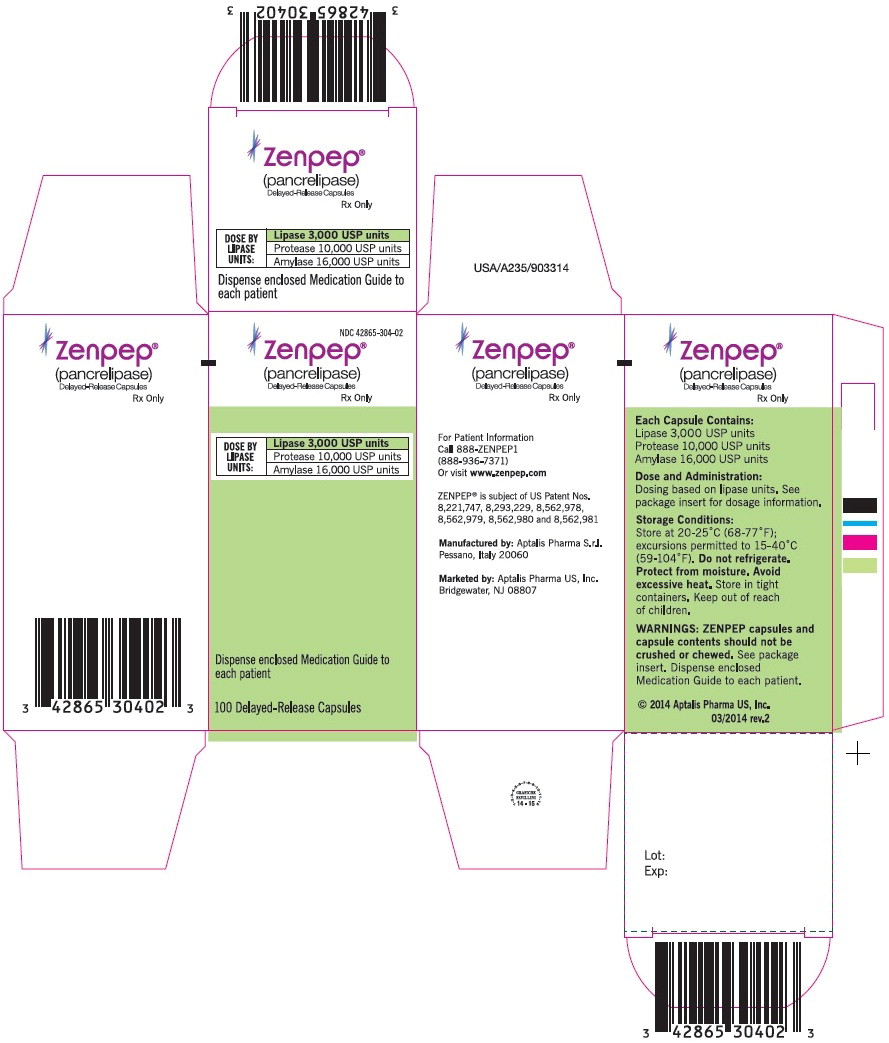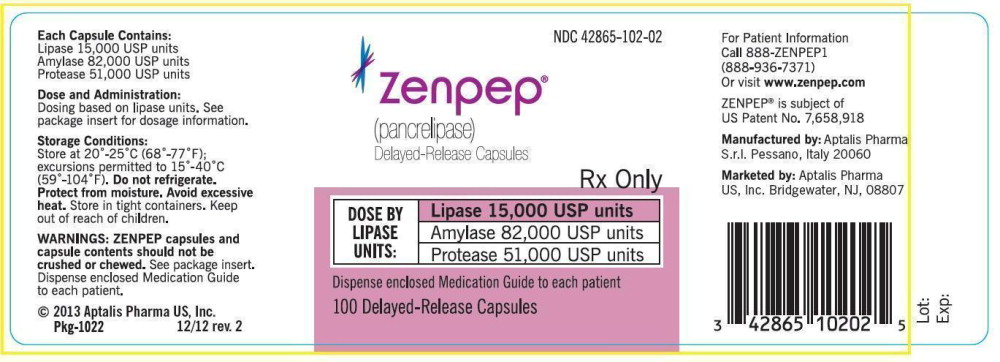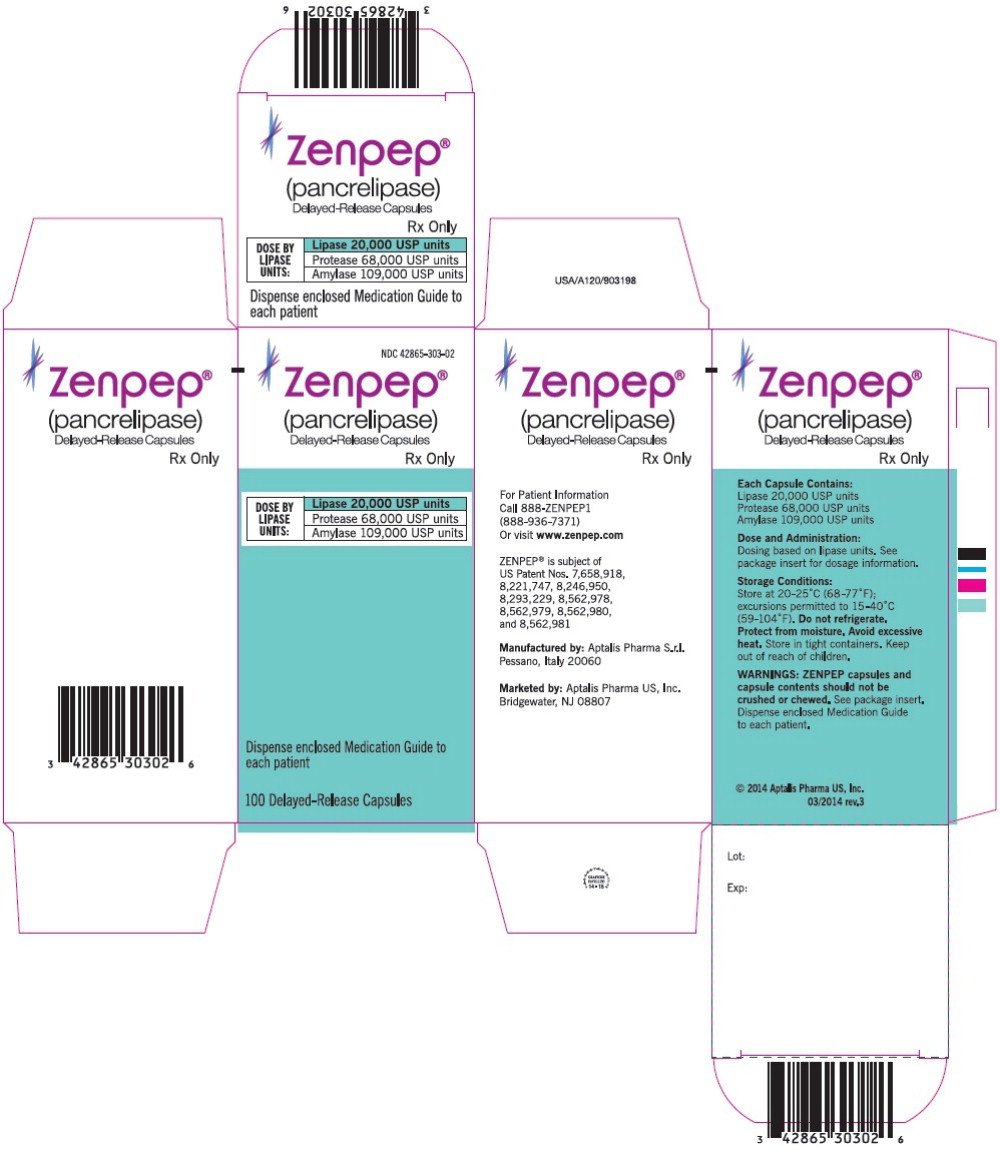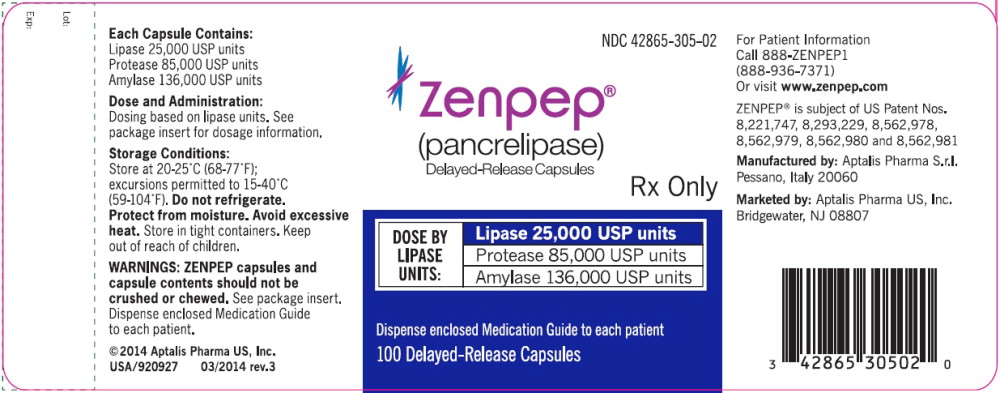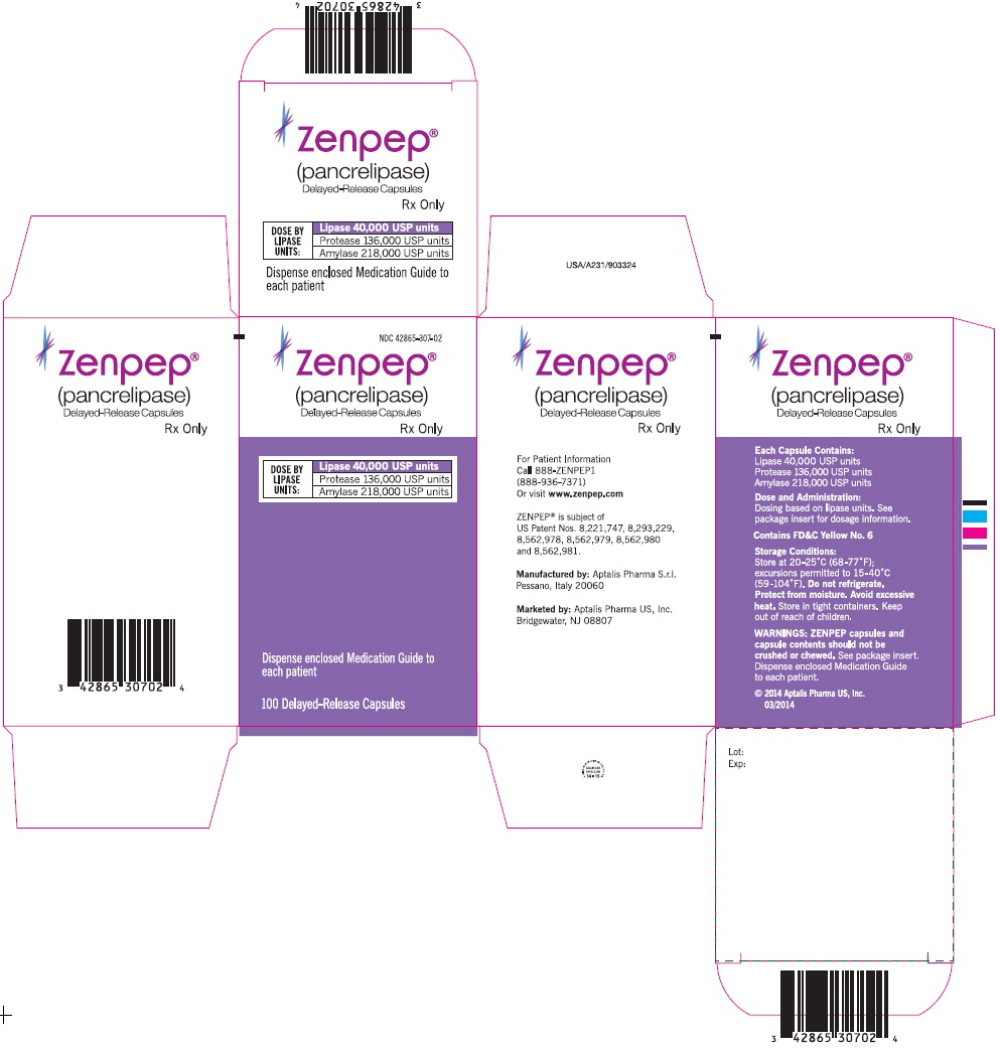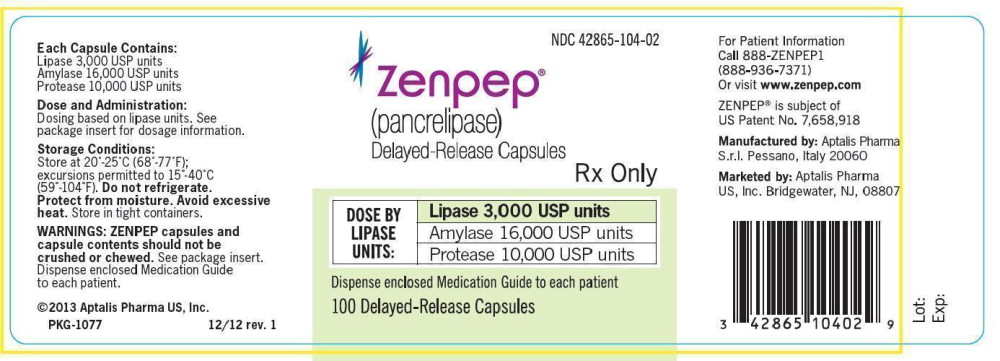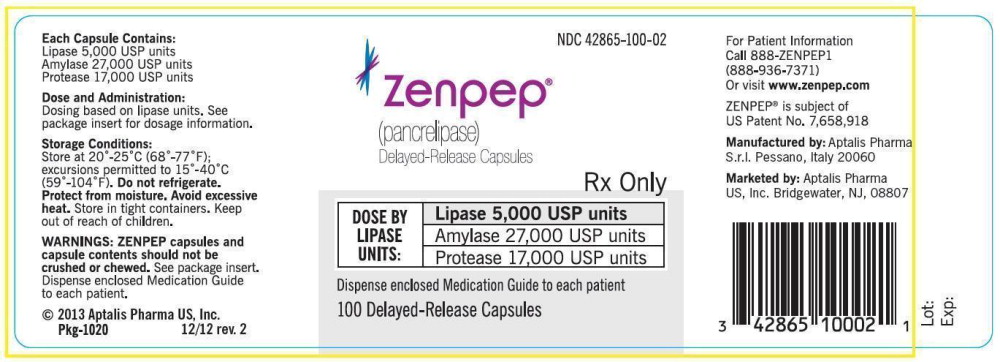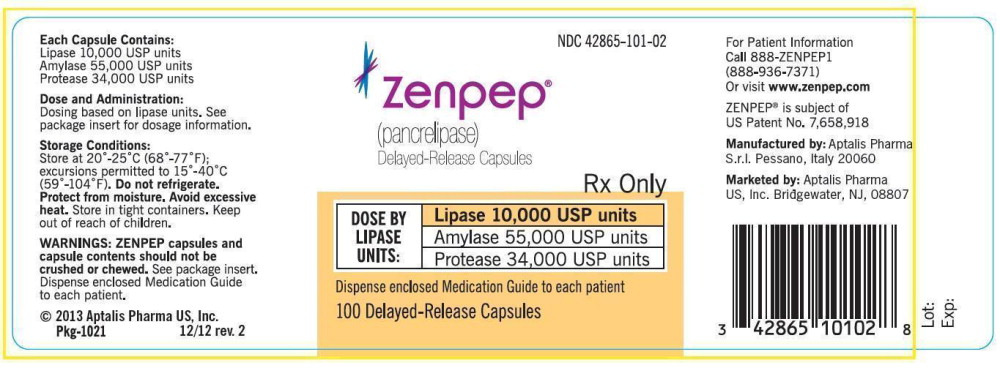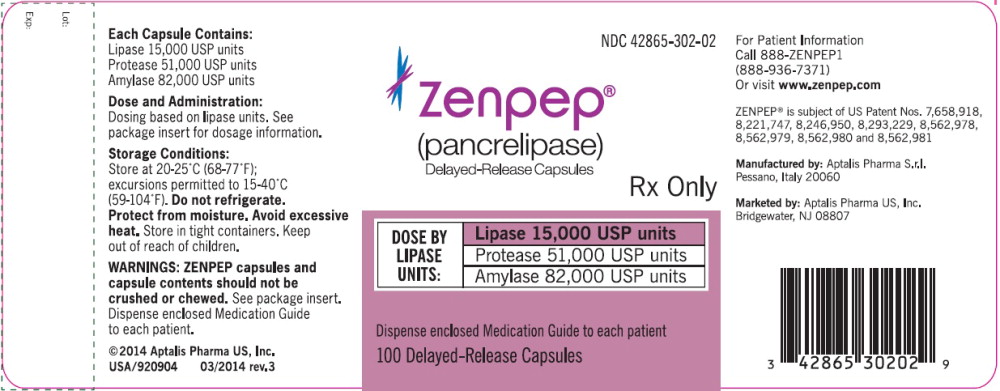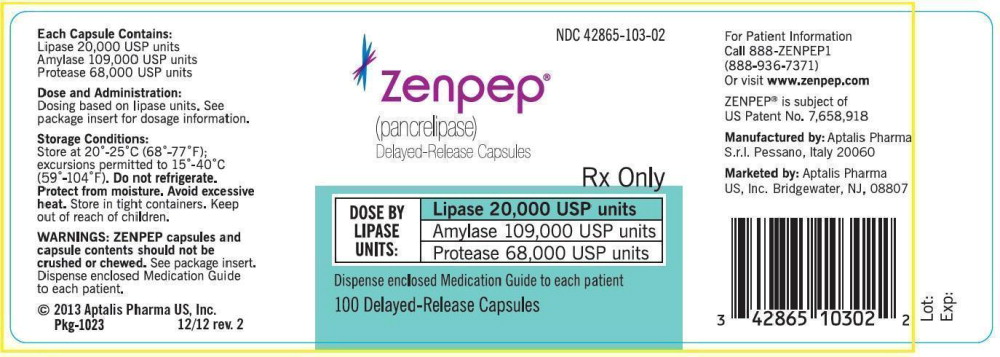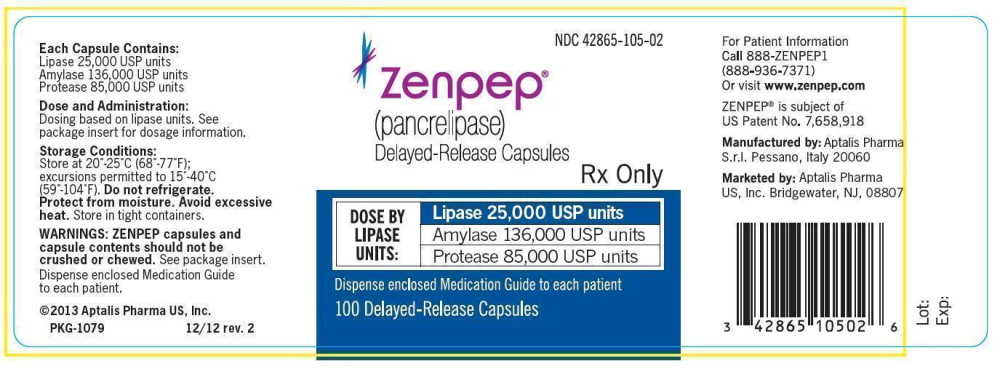ZENPEP- pancrelipase capsule, delayed release
ZENPEP by
Drug Labeling and Warnings
ZENPEP by is a Prescription medication manufactured, distributed, or labeled by Allergan, Inc.. Drug facts, warnings, and ingredients follow.
Drug Details [pdf]
-
HIGHLIGHTS OF PRESCRIBING INFORMATION
These highlights do not include all the information needed to use ZENPEP safely and effectively. See full prescribing information for ZENPEP.
ZENPEP® (pancrelipase) delayed release capsules
Initial U.S. Approval: 2009INDICATIONS AND USAGE
ZENPEP® is a combination of porcine-derived lipases, proteases, and amylases indicated for the treatment of exocrine pancreatic insufficiency due to cystic fibrosis, or other conditions (1)
DOSAGE AND ADMINISTRATION
Dosage
ZENPEP is not interchangeable with any other pancrelipase product.
Infants (up to 12 months)- Infants may be given 3,000 lipase units (one capsule) per 120 mL of formula or per breast-feeding. (2.1)
- Do not mix ZENPEP capsule contents directly into formula or breast milk prior to administration. (2.2)
Children Older than 12 Months and Younger than 4 Years
- Enzyme dosing should begin with 1,000 lipase units/kg of body weight per meal to a maximum of 2,500 lipase units/kg of body weight per meal (or less than or equal to 10,000 lipase units/kg of body weight per day), or less than 4,000 lipase units/g fat ingested per day. (2.1)
Children 4 Years and Older and Adults
- Enzyme dosing should begin with 500 lipase units/kg of body weight per meal to a maximum of 2,500 lipase units/kg of body weight per meal (or less than or equal to 10,000 lipase units/kg of body weight per day), or less than 4,000 lipase units/g fat ingested per day. (2.1)
Limitations on Dosing
- Dosing should not exceed the recommended maximum dosage set forth by the Cystic Fibrosis Foundation Consensus Conferences Guidelines (2.1)
Administration
- ZENPEP should be swallowed whole. For infants or patients unable to swallow intact capsules, the contents may be sprinkled on soft acidic food, e.g., applesauce. (2.2)
DOSAGE FORMS AND STRENGTHS
- Capsules: 3,000 USP units of lipase; 10,000 USP units of protease; 16,000 USP units of amylase. Capsules have a white opaque cap and body, printed with “APTALIS 3” (3)
- Capsules: 5,000 USP units of lipase; 17,000 USP units of protease; 27,000 USP units of amylase. Capsules have a white opaque cap and body, printed with “APTALIS 5” (3)
- Capsules: 10,000 USP units of lipase; 34,000 USP units of protease; 55,000 USP units of amylase. Capsules have a yellow opaque cap and white opaque body, printed with “APTALIS 10” (3)
- Capsules: 15,000 USP units of lipase; 51,000 USP units of protease; 82,000 USP units of amylase. Capsules have a red opaque cap and white opaque body, printed with “APTALIS 15” (3)
- Capsules: 20,000 USP units of lipase; 68,000 USP units of protease; 109,000 USP units of amylase. Capsules have a green opaque cap and white opaque body, printed with “APTALIS 20” (3)
- Capsules: 25,000 USP units of lipase; 85,000 USP units of protease; 136,000 USP units of amylase. Capsules have a blue opaque cap and white opaque body, printed with “APTALIS 25" (3)
- Capsules: 40,000 USP units of lipase; 136,000 USP units of protease; 218,000 USP units of amylase. Capsules have a orange opaque cap and white opaque body, printed with “APTALIS 40" (3)
CONTRAINDICATIONS
None (4)
WARNINGS AND PRECAUTIONS
- Fibrosing colonopathy is associated with high-dose use of pancreatic enzyme replacement. Exercise caution when doses of ZENPEP exceed 2,500 lipase units/kg of body weight per meal (or greater than 10,000 lipase units/kg of body weight per day). (5.1)
- To avoid irritation of oral mucosa, do not chew ZENPEP or retain in the mouth. (5.2)
- Exercise caution when prescribing ZENPEP to patients with gout, renal impairment, or hyperuricemia. (5.3)
- There is theoretical risk of viral transmission with all pancreatic enzyme products including ZENPEP. (5.4)
- Exercise caution when administering pancrelipase to a patient with a known allergy to proteins of porcine origin. (5.5)
ADVERSE REACTIONS
- The most common adverse events (≥6% of patients treated with ZENPEP) are abdominal pain, flatulence, headache, cough, decreased weight, early satiety, and contusion. (6.1)
To report SUSPECTED ADVERSE REACTIONS, contact Aptalis Pharma at 1-888-936-7371 or FDA at 1-800-FDA-1088 or www.fda.gov/medwatch
USE IN SPECIFIC POPULATIONS
Pediatric Patients:
- The safety and effectiveness of ZENPEP were assessed in pediatric patients, ages 1 to 17 years. (8.4)
- The safety and efficacy of pancreatic enzyme products with different formulations of pancrelipase in pediatric patients have been described in the medical literature and through clinical experience. (8.4)
See 17 for PATIENT COUNSELING INFORMATION and Medication Guide.
Revised: 3/2014
-
Table of Contents
FULL PRESCRIBING INFORMATION: CONTENTS*
1 INDICATIONS AND USAGE
2 DOSAGE AND ADMINISTRATION
2.1 Dosage
2.2 Administration
3 DOSAGE FORMS AND STRENGTHS
4 CONTRAINDICATIONS
5 WARNINGS AND PRECAUTIONS
5.1 Fibrosing Colonopathy
5.2 Potential for Irritation to Oral Mucosa
5.3 Potential for Risk of Hyperuricemia
5.4 Potential Viral Exposure from the Product Source
5.5 Allergic Reactions
6 ADVERSE REACTIONS
6.1 Clinical Trials Experience
6.2 Postmarketing Experience
7 DRUG INTERACTIONS
8 USE IN SPECIFIC POPULATIONS
8.1 Pregnancy
8.3 Nursing Mothers
8.4 Pediatric Use
8.5 Geriatric Use
10 OVERDOSAGE
11 DESCRIPTION
12 CLINICAL PHARMACOLOGY
12.1 Mechanism of Action
12.3 Pharmacokinetics
13 NONCLINICAL TOXICOLOGY
13.1 Carcinogenesis, Mutagenesis, Impairment of Fertility
14 CLINICAL STUDIES
15 REFERENCES
16 HOW SUPPLIED/STORAGE AND HANDLING
17 PATIENT COUNSELING INFORMATION
17.1 Dosing and Administration
17.2 Fibrosing Colonopathy
17.3 Allergic Reactions
17.4 Pregnancy and Breast Feeding
- * Sections or subsections omitted from the full prescribing information are not listed.
- 1 INDICATIONS AND USAGE
-
2 DOSAGE AND ADMINISTRATION
2.1 Dosage
ZENPEP is not interchangeable with other pancrelipase products.
ZENPEP is orally administered. Therapy should be initiated at the lowest recommended dose and gradually increased. The dosage of ZENPEP should be individualized based on clinical symptoms, the degree of steatorrhea present, and the fat content of the diet (see Limitations on Dosing below).
Dosage recommendations for pancreatic enzyme replacement therapy were published following the Cystic Fibrosis Foundation Consensus Conferences.1, 2, 3 ZENPEP should be administered in a manner consistent with the recommendations of the Conferences provided in the following paragraphs, with one exception. The Conferences recommend doses of 2,000 to 4,000 lipase units in infants up to 12 months. ZENPEP is available in a 3,000 lipase unit capsule. The recommended dose of ZENPEP in infants up to 12 months is 3,000 lipase units. Patients may be dosed on a fat ingestion-based or actual body weight-based dosing scheme.
Infants (up to 12 months)
Infants may be given 3,000 lipase units (one capsule) per 120 mL of formula or breast-feeding. Do not mix ZENPEP capsule contents directly into formula or breast milk prior to administration [see Dosage and Administration (2.2)].Children Older than 12 Months and Younger than 4 Years
Enzyme dosing should begin with 1,000 lipase units/kg of body weight per meal for children less than age 4 years to a maximum of 2,500 lipase units/kg of body weight per meal (or less than or equal to 10,000 lipase units/kg of body weight per day), or less than 4,000 lipase units/g fat ingested per day.Children 4 Years and Older and Adults
Enzyme dosing should begin with 500 lipase units/kg of body weight per meal for those older than age 4 years to a maximum of 2,500 lipase units/kg of body weight per meal (or less than or equal to 10,000 lipase units/kg of body weight per day), or less than 4,000 lipase units/g fat ingested per day.Usually, half of the prescribed ZENPEP dose for an individualized full meal should be given with each snack. The total daily dose should reflect approximately three meals plus two or three snacks per day.
Enzyme doses expressed as lipase units/kg of body weight per meal should be decreased in older patients because they weigh more but tend to ingest less fat per kilogram of body weight.
Limitations on Dosing
Dosing should not exceed the recommended maximum dosage set forth by the Cystic Fibrosis Foundation Consensus Conferences Guidelines.1, 2, 3If symptoms and signs of steatorrhea persist, the dosage may be increased by a healthcare professional. Patients should be instructed not to increase the dosage on their own. There is great inter-individual variation in response to enzymes; thus, a range of doses is recommended. Changes in dosage may require an adjustment period of several days. If doses are to exceed 2,500 lipase units/kg of body weight per meal, further investigation is warranted.
Doses greater than 2,500 lipase units/kg of body weight per meal (or greater than 10,000 lipase units/kg of body weight per day) should be used with caution and only if they are documented to be effective by 3-day fecal fat measures that indicate a significantly improved coefficient of fat absorption. Doses greater than 6,000 lipase units/kg of body weight per meal have been associated with colonic strictures, indicative of fibrosing colonopathy, in children with cystic fibrosis less than 12 years of age [see Warnings and Precautions (5.1)]. Patients currently receiving higher doses than 6,000 lipase units/kg of body weight per meal should be examined and the dosage either immediately decreased or titrated downward to a lower range.
2.2 Administration
ZENPEP should always be taken as prescribed by a healthcare professional.
Infants (up to 12 months)
ZENPEP should be administered to infants immediately prior to each feeding, using a dosage of 3,000 lipase units (one capsule) per 120 mL of formula or per breast-feeding. Contents of the capsule may be administered with a small amount of applesauce, or other acidic food with a pH of 4.5 or less (e.g., commercially available preparations of bananas, or pears). Contents of the capsule may also be administered directly to the mouth. Administration should be followed by breast milk or formula. Contents of the capsule should not be mixed directly into formula or breast milk as this may diminish efficacy. Care should be taken to ensure that ZENPEP is not crushed or chewed or retained in the mouth, to avoid irritation of the oral mucosa.Children and Adults
ZENPEP should be taken during meals or snacks, with sufficient fluid. ZENPEP capsules and capsule contents should not be crushed or chewed. Capsules should be swallowed whole.For patients who are unable to swallow intact capsules, the capsules may be carefully opened and the contents sprinkled on small amounts of acidic soft food of pH 4.5 or less (e.g., commercially available preparations of bananas, pears and applesauce).
The ZENPEP -soft food mixture should be swallowed immediately without crushing or chewing, and followed with water or juice to ensure complete ingestion. Care should be taken to ensure that no drug is retained in the mouth.
-
3 DOSAGE FORMS AND STRENGTHS
The active ingredient in ZENPEP evaluated in clinical trials is lipase. ZENPEP is dosed by lipase units.
ZENPEP is available in 7 color coded capsule strengths.
Other active ingredients include protease and amylase. Each ZENPEP capsule strength contains the specified amounts of lipase, protease, and amylase.Capsules of all strengths have a blue radial print on the capsule body and are colored as follows:
- 3,000 USP units of lipase; 10,000 USP units of protease; 16,000 USP units of amylase capsules have a white opaque cap and white opaque body, red imprint with “APTALIS 3”
- 5,000 USP units of lipase; 17,000 USP units of protease; 27,000 USP units of amylase capsules have a white opaque cap and white opaque body, printed with “APTALIS 5”
- 10,000 USP units of lipase; 34,000 USP units of protease; 55,000 USP units of amylase capsules have a yellow opaque cap and white opaque body, printed with “APTALIS 10”
- 15,000 USP units of lipase; 51,000 USP units of protease; 82,000 USP units of amylase capsules have a red opaque cap and white opaque body, printed with “APTALIS 15”
- 20,000 USP units of lipase; 68,000 USP units of protease; 109,000 USP units of amylase capsules have a green opaque cap and white opaque body, printed with “APTALIS 20”
- 25,000 USP units of lipase; 85,000 USP units of protease; 136,000 USP units of amylase capsules have a blue opaque cap and white opaque body, blue imprint with “APTALIS 25”
- 40,000 USP units of lipase; 136,000 USP units of protease; 218,000 USP units of amylase capsules have a orange opaque cap and white opaque body, printed with “APTALIS 40”
- 4 CONTRAINDICATIONS
-
5 WARNINGS AND PRECAUTIONS
5.1 Fibrosing Colonopathy
Fibrosing colonopathy has been reported following treatment with different pancreatic enzyme products. Fibrosing colonopathy is a rare serious adverse reaction initially described in association with high-dose pancreatic enzyme use, usually with use over a prolonged period of time and most commonly reported in pediatric patients with cystic fibrosis. The underlying mechanism of fibrosing colonopathy remains unknown. Doses of pancreatic enzyme products exceeding 6,000 lipase units/kg of body weight per meal have been associated with colonic strictures in children less than 12 years of age.1 Patients with fibrosing colonopathy should be closely monitored because some patients may be at risk of progressing to stricture formation. It is uncertain whether regression of fibrosing colonopathy occurs. It is generally recommended, unless clinically indicated, that enzyme doses should be less than 2,500 lipase units/kg of body weight per meal (or less than 10,000 lipase units/kg of body weight per day) or less than 4,000 lipase units/g fat ingested per day [see Dosage and Administration (2.1)].
Doses greater than 2,500 lipase units/kg of body weight per meal (or greater than 10,000 lipase units/kg of body weight per day) should be used with caution and only if they are documented to be effective by 3-day fecal fat measures that indicate a significantly improved coefficient of fat absorption. Patients receiving higher doses than 6,000 lipase units/kg of body weight per meal should be examined and the dosage either immediately decreased or titrated downward to a lower range.
5.2 Potential for Irritation to Oral Mucosa
Care should be taken to ensure that no drug is retained in the mouth. ZENPEP should not be crushed or chewed or mixed in foods having a pH greater than 4.5. These actions can disrupt the protective enteric coating resulting in early release of enzymes, irritation of oral mucosa, and/or loss or enzyme activity [see Dosage and Administration (2.2) and Patient Counseling Information (17.1)]. For patients who are unable to swallow intact capsules, the capsules may be carefully opened and the contents added to a small amount of acidic soft food with a pH of 4.5 or less, such as applesauce. The ZENPEP-soft food mixture should be swallowed immediately and followed with water or juice to ensure complete ingestion.
5.3 Potential for Risk of Hyperuricemia
Caution should be exercised when prescribing ZENPEP to patients with gout, renal impairment, or hyperuricemia. Porcine-derived pancreatic enzyme products contain purines that may increase blood uric acid levels.
5.4 Potential Viral Exposure from the Product Source
ZENPEP is sourced from pancreatic tissue from swine used for food consumption. Although the risk that ZENPEP will transmit an infectious agent to humans has been reduced by testing for certain viruses during manufacturing and by inactivating certain viruses during manufacturing, there is a theoretical risk for transmission of viral disease, including diseases caused by novel or unidentified viruses. Thus, the presence of porcine viruses that might infect humans cannot be definitely excluded. However, no cases of transmission of an infectious illness associated with the use of porcine pancreatic extracts have been reported.
5.5 Allergic Reactions
Caution should be exercised when administering pancrelipase to a patient with a known allergy to proteins of porcine origin. Rarely, severe allergic reactions including anaphylaxis, asthma, hives, and pruritus, have been reported with other pancreatic enzyme products with different formulations of the same active ingredient (pancrelipase). The risks and benefits of continued ZENPEP treatment in patients with severe allergy should be taken into consideration with the overall clinical needs of the patient.
-
6 ADVERSE REACTIONS
The most serious adverse reactions reported with different pancreatic enzyme products of the same active ingredient (pancrelipase) include fibrosing colonopathy, hyperuricemia and allergic reactions [see Warnings and Precautions (5)].
6.1 Clinical Trials Experience
Because clinical trials are conducted under widely varying conditions, adverse reaction rates observed in the clinical trials of a drug cannot be directly compared to the rates in the clinical trials of another drug and may not reflect the rates observed in clinical practice.
The short-term safety of ZENPEP was assessed in two clinical trials conducted in 53 patients, ages 1 to 23 years, with exocrine pancreatic insufficiency (EPI) due to CF. In both studies, ZENPEP was administered in doses of approximately 5,000 lipase units per kilogram per day, for lengths of treatment ranging from 19 to 42 days. The population was nearly evenly distributed in gender, and approximately 96% of patients were Caucasian.
Study 1 was a randomized, double-blind, placebo-controlled, 2-treatment, crossover study of 34 patients, ages 7 to 23 years, with EPI due to CF. In this study, patients were randomized to receive ZENPEP at individually titrated doses (not to exceed 2,500 lipase units per kilogram per meal) or matching placebo for 6 to 7 days of treatment, followed by crossover to the alternate treatment for an additional 6 to 7 days. The mean exposure to ZENPEP during this study, including titration period and open label transition, was 30 days.
The incidence of adverse events (regardless of causality) was similar during double blind ZENPEP treatment (56%) and placebo treatment (50%). The most common adverse events reported during the study were gastrointestinal complaints, which were reported more commonly during placebo treatment (41%) than during ZENPEP treatment (32%), and headache, which was reported more commonly during ZENPEP treatment (15%) than during placebo treatment (0). The type and incidence of adverse events were similar in children (7-11 years), adolescents (12-16 years), and adults (greater than 18 years).
Because clinical trials are conducted under controlled conditions, the observed adverse event rates may not reflect the rates observed in clinical practice.
Table 1 enumerates treatment-emergent adverse events that occurred in at least 2 patients (greater than or equal to 6%) treated with either ZENPEP or placebo in Study 1. Adverse events were classified by Medical Dictionary for Regulatory Activities (MedDRA) terminology.
Table 1: Treatment-Emergent Adverse Events Occurring in at least 2 Patients (greater than or equal to 6%) During Treatment Period and Crossover Treatment Period of the Placebo-Controlled, Crossover Clinical Study of ZENPEP (Study 1)
MedDRA Primary System Organ Class Preferred Term ZENPEP
(N=34) %Placebo
(N=32) %Gastrointestinal Disorders Abdominal pain 6 (18%) 9 (28%) Flatulence 2 (6%) 3 (9%) Nervous System Disorders Headache 5 (15%) 0 Injury, Poisoning and Procedural Complications Contusion 2 (6%) 0 Investigations Weight decreased 2 (6%) 2 (6%) Respiratory, Thoracic and Mediastinal Disorders Cough 2 (6%) 0 General Disorders and Administration Site Conditions Early Satiety 2 (6%) 0 Study 2 was an open-label, uncontrolled study of 19 patients, ages 1 to 6 years, with EPI due to CF. After a 4-14 days screening period on the current PEP, patients in Study 2 received ZENPEP at individually titrated doses ranging between 2,300 and 10,000 lipase units per kg body weight per day, with a mean of approximately 5,000 lipase units per kg body weight per day (not to exceed 2,500 lipase units per kilogram per meal) for 14 days. There was no comparator treatment, and adverse events were collected on patient diary entries and at each study visit.
The most commonly reported adverse events were gastrointestinal, including abdominal pain and steatorrhea, and were similar in type and frequency to those reported in the double-blind, placebo-controlled trial (Study 1).
6.2 Postmarketing Experience
Postmarketing data for ZENPEP have been available since 2009. The following adverse reactions have been identified during post-approval use of Zenpep. Because these reactions are reported voluntarily from a population of uncertain size, it is not always possible to reliably estimate their frequency or establish a causal relationship to drug exposure.
The most commonly reported adverse events are gastrointestinal disorders (including abdominal distension, abdominal pain, diarrhea, flatulence, constipation and nausea) and skin disorders (including pruritus, urticaria, and rash).
In patients at risk for abnormal blood glucose levels glycemic control may be affected by administration of pancreatic enzyme replacement therapy. Consideration should be given to additional glucose monitoring in these patients.
Delayed- and immediate-release pancreatic enzyme products with different formulations of the same active ingredient (pancrelipase) have been used for the treatment of patients with exocrine pancreatic insufficiency due to cystic fibrosis and other conditions, such as chronic pancreatitis. The long-term safety profile of these products has been described in the medical literature. The most serious adverse events include fibrosing colonopathy, distal intestinal obstruction syndrome (DIOS), recurrence of pre-existing carcinoma, and severe allergic reactions including anaphylaxis, asthma, hives, and pruritus.
In general, pancreatic enzyme products have a well defined and favorable risk-benefit profile in exocrine pancreatic insufficiency.
- 7 DRUG INTERACTIONS
-
8 USE IN SPECIFIC POPULATIONS
8.1 Pregnancy
Teratogenic effects
Pregnancy Category C: Animal reproduction studies have not been conducted with pancrelipase. It is also not known whether pancrelipase can cause fetal harm when administered to a pregnant woman or can affect reproduction capacity. ZENPEP should be given to a pregnant woman only if clearly needed. The risk and benefit of pancrelipase should be considered in the context of the need to provide adequate nutritional support to a pregnant woman with exocrine pancreatic insufficiency. Adequate caloric intake during pregnancy is important for normal maternal weight gain and fetal growth. Reduced maternal weight gain and malnutrition can be associated with adverse pregnancy outcomes.8.3 Nursing Mothers
It is not known whether this drug is excreted in human milk. Because many drugs are excreted in human milk, caution should be exercised when ZENPEP is administered to a nursing woman. The risk and benefit of pancrelipase should be considered in the context of the need to provide adequate nutritional support to a nursing mother with exocrine pancreatic insufficiency.
8.4 Pediatric Use
The short-term safety and effectiveness of ZENPEP were assessed in 2 clinical studies in pediatric patients, ages 1 to 17 years, with EPI due to CF.
Study 1 was a randomized, double-blind, placebo-controlled, crossover study in 34 patients 26 of whom were children, including 8 children aged 7 to 11 years, and 18 adolescents aged 12 to 17 years. The safety and efficacy in pediatric patients in this study were similar to adult patients [see Adverse Reactions (6.1) and Clinical Studies (14)].
Study 2 was an open-label, single arm study in 19 patients, ages 1 to 6 years, with EPI due to CF. When patient regimen was switched from their usual PEP regimen to ZENPEP at similar doses, patients showed similar control of their clinical symptoms.
The safety and efficacy of pancreatic enzyme products with different formulations of pancrelipase consisting of the same active ingredient (lipases, proteases, and amylases) for treatment of children with exocrine pancreatic insufficiency due to cystic fibrosis has been described in the medical literature and through clinical experience.
Dosing of pediatric patients should be in accordance with recommended guidance from the Cystic Fibrosis Foundation Consensus Conferences [see Dosage and Administration (2.1)]. Doses of other pancreatic enzyme products exceeding 6,000 lipase units/kg of body weight per meal have been associated with fibrosing colonopathy and colonic strictures in children less than 12 years of age [see Warnings and Precautions (5.1)].
-
10 OVERDOSAGE
In Study 1, a 10 year-old patient was administered a dose of 10,856 lipase units per kg body weight of ZENPEP for a period of one day. The patient did not experience any adverse events as a result of the dose increase, nor did this patient experience any adverse events during a 44-day follow-up period. No abnormalities from analyses of safety labs (chemistry, hematology, urinalysis or uric acid) were noted.
Chronic high doses of pancreatic enzyme products have been associated with fibrosing colonopathy and colonic strictures [see Dosage and Administration (2.1) and Warnings and Precautions (5.1)]. High doses of pancreatic enzyme products have been associated with hyperuricosuria and hyperuricemia, and should be used with caution in patients with a history of hyperuricemia, gout, or renal impairment [see Warnings and Precautions (5.3)].
-
11 DESCRIPTION
ZENPEP is a pancreatic enzyme preparation consisting of pancrelipase, an extract derived from porcine pancreatic glands. Pancrelipase contains multiple enzyme classes, including porcine-derived lipases, proteases, and amylases.
Pancrelipase is a cream-colored powder. It is miscible in water and practically insoluble or insoluble in alcohol and ether.
Each capsule for oral administration contains enteric-coated beads (1.8-1.9mm for 3,000 and 5,000 USP units of lipase, 2.2-2.5mm for 10,000, 15,000, 20,000, 25,000, and 40,000 USP units of lipase).
The active ingredient evaluated in clinical trials is lipase. ZENPEP is dosed by lipase units.
Other active ingredients include protease and amylase.Inactive ingredients in ZENPEP include colloidal silicon dioxide, croscarmellose sodium, hydrogenated castor oil, hypromellose phthalate, magnesium stearate, microcrystalline cellulose, talc, and triethyl citrate and are contained in hypromellose capsules. The imprinting red ink on the 3,000 capsules strength contains, antifoam DC 1510, industrial methylated spirit, iron oxide red C.I. 77491-E172, n-butyl alcohol, shellac and soya lecithin.
3,000 USP units of lipase; 10,000 USP units of protease; 16,000 USP units of amylase. Capsules have a white opaque cap and a white opaque body with imprint “APTALIS 3”. The shells contain carnauba wax or talc, carrageenan, hypromellose, potassium chloride, titanium oxide, and water.
The imprinting blue ink on the capsules strengths 5,000, 10,000, 15,000, 20,000, 25,000 and 40,000 contains dehydrated alcohol, FD&C Blue #2 aluminum lake C.I. 73015-E132, isopropyl alcohol, n-butyl alcohol, propylene glycol, shellac and strong ammonia solution.
5,000 USP units of lipase; 17,000 USP units of protease; 27,000 USP units of amylase. Capsules have a white opaque cap and a white opaque body with imprint “APTALIS 5”. The shells contain carnauba wax or talc, carrageenan, hypromellose, potassium chloride, titanium oxide, and water.
10,000 USP units of lipase; 34,000 USP units of protease; 55,000 USP units of amylase. Capsules have a yellow opaque cap and a white opaque body with imprint “APTALIS 10”. The shells contain carnauba wax or talc, carrageenan, hypromellose, potassium chloride, titanium oxide, water and yellow ferric oxide.
15,000 USP units of lipase; 51,000 USP units of protease; 82,000 USP units of amylase. Capsules have a red opaque cap and a white opaque body with imprint “APTALIS 15”. The shells contain carnauba wax or talc, carrageenan, hypromellose, potassium chloride, red ferric oxide, titanium oxide, and water.
20,000 USP units of lipase; 68,000 USP units of protease; 109,000 USP units of amylase. Capsules have a green opaque cap and a white opaque body with imprint “APTALIS 20”. The shells contain carnauba wax or talc, carrageenan, FD&C Blue #2, hypromellose, potassium chloride, titanium oxide, water, and yellow ferric oxide.
25,000 USP units of lipase; 85,000 USP units of protease; 136,000 USP units of amylase. Capsules have a blue opaque cap and a white opaque body with imprint “APTALIS 25”. The shells contain carnauba wax or talc, carrageenan, FD&C Blue #2, hypromellose, potassium chloride, titanium oxide, and water.
40,000 USP units of lipase; 136,000 USP units of protease; 218,000 USP units of amylase. Capsules have a orange opaque cap and white opaque body, printed with “APTALIS 40”. The shells contain FD&C Yellow #6, hypromellose, titanium oxide and water.
-
12 CLINICAL PHARMACOLOGY
12.1 Mechanism of Action
The pancreatic enzymes in ZENPEP catalyze the hydrolysis of fats to monoglycerides, glycerol, and free fatty acids, protein into peptides and amino acids, and starch into dextrins and short chain sugars such as maltose and maltriose in the duodenum and proximal small intestine, thereby acting like digestive enzymes physiologically secreted by the pancreas.
12.3 Pharmacokinetics
The pancreatic enzymes in ZENPEP are enteric-coated to minimize destruction or inactivation in gastric acid. ZENPEP is designed to release most of the enzymes in vivo at pH greater than 5.5. Pancreatic enzymes are not absorbed from the gastrointestinal tract in any appreciable amount.
- 13 NONCLINICAL TOXICOLOGY
-
14 CLINICAL STUDIES
The short-term safety and efficacy of ZENPEP were evaluated in 2 studies conducted in 53 patients, ages 1 to 23 years, with exocrine pancreatic insufficiency (EPI) associated with cystic fibrosis (CF).
Study 1, was a randomized, double-blind, placebo-controlled, crossover study of 34 patients, ages 7 to 23 years, with EPI due to CF. The final analysis population was limited to 32 patients, who completed both double-blind treatment periods, and were included in the efficacy analysis population. Patients were randomized to receive ZENPEP or matching placebo for 6 to 7 days of treatment, followed by crossover to the alternate treatment for an additional 6 to 7 days. The mean dose during the controlled treatment periods ranged from a mean dose of 3,900 lipase units per kilogram per day to 5,700 lipase units per kilogram per day. All patients consumed a high-fat diet (greater than or equal to 100 grams of fat per day) during the treatment period.
The primary efficacy endpoint was the mean difference in the coefficient of fat absorption (CFA) between ZENPEP and placebo treatment. The CFA was determined by a 72-hour stool collection during both treatments, when both fat excretion and fat ingestion were measured. Each patient’s CFA during placebo treatment was used as their no-treatment CFA value.
Mean CFA was 88% with ZENPEP treatment compared to 63% with placebo treatment. The mean difference in CFA was 26 percentage points in favor of ZENPEP treatment with 95% Confidence Interval of (19, 32) and p≤0.001.
Subgroup analyses of the CFA results showed that mean change in CFA was greater in patients with lower no-treatment (placebo) CFA values than in patients with higher no-treatment (placebo) CFA values. There were similar responses to ZENPEP by age and gender.
Study 2, was an open-label, uncontrolled study of 19 patients, ages 1 to 6 years (mean age 4 years), with EPI due to CF. Approximately half of the patients were ages 1 to 3 years. Study 2 compared a measurement of fat malabsorption, spot fecal fat testing, before (while receiving therapy with another commercial PEP) and after oral administration of Zenpep capsules with each meal or snack.
All patients in Study 2 were transitioned to ZENPEP from their usual PEP treatment. After a 4-14 days screening period on the current PEP, patients in Study 2 received ZENPEP at individually titrated doses ranging between 2,300 and 10,000 lipase units per kg body weight per day, with a mean of approximately 5,000 lipase units per kg body weight per day (not to exceed 2,500 lipase units per kilogram per meal) for 14 days. There was no wash-out period. Overall, patients showed similar control of fat malabsorption by spot fecal fat testing when switched to ZENPEP treatment at similar doses.
-
15 REFERENCES
- Borowitz DS, Grand RJ, Durie PR, et al. Use of pancreatic enzyme supplements for patients with cystic fibrosis in the context of fibrosing colonopathy. Journal of Pediatrics. 1995; 127: 681-684.
- Borowitz DS, Baker RD, Stallings V. Consensus report on nutrition for pediatric patients with cystic fibrosis. Journal of Pediatric Gastroenterology Nutrition. 2002 Sep; 35: 246-259.
- Stallings VA, Start LJ, Robinson KA, et al. Evidence-based practice recommendations for nutrition-related management of children and adults with cystic fibrosis and pancreatic insufficiency: results of a systematic review. Journal of the American Dietetic Association. 2008; 108: 832-839.
- Smyth RL, Ashby D, O’Hea U, et al. Fibrosing colonopathy in cystic fibrosis: results of a case-control study.9 Lancet. 1995; 346: 1247-1251.
- FitzSimmons SC, Burkhart GA, Borowitz DS, et al. High-dose pancreatic-enzyme supplements and fibrosing colonopathy in children with cystic fibrosis. New England Journal of Medicine. 1997; 336: 1283-1289
-
16 HOW SUPPLIED/STORAGE AND HANDLING
ZENPEP® (pancrelipase) Delayed-Release Capsules
3,000 USP units of lipase; 10,000 USP units of protease; 16,000 units of amylase.
Each ZENPEP capsule is available as a two piece hypromellose capsule with white opaque cap and white body with a red radial print and printed with “APTALIS 3”, that contains 1.8-1.9mm enteric-coated beads. Capsules are supplied in bottles of:- 12 capsules (NDC: 42865-304-01)
- 100 capsules (NDC: 42865-304-02)
ZENPEP® (pancrelipase) Delayed-Release Capsules
5,000 USP units of lipase; 17,000 USP units of protease; 27,000 units of amylase.
Each ZENPEP capsule is available as a two piece hypromellose capsule with white opaque cap and white body with a blue radial print and printed with “APTALIS 5”, that contains 1.8-1.9mm enteric-coated beads. Capsules are supplied in bottles of:
- 12 capsules (NDC: 42865-300-01)
- 100 capsules (NDC: 42865-300-02)
ZENPEP® (pancrelipase) Delayed-Release Capsules
10,000 USP units of lipase; 34,000 units of protease; 55,000 units of amylase.Each ZENPEP capsule is available as a two piece hypromellose capsule with yellow opaque cap and white body with a blue radial print and printed with “APTALIS 10”, that contains 2.2-2.5mm enteric-coated beads. Capsules are supplied in bottles of:
- 12 capsules (NDC: 42865-306-01)
- 100 capsules (NDC: 42865-306-02)
ZENPEP® (pancrelipase) Delayed-Release Capsules
15,000 USP units of lipase; 51,000 units of protease; 82,000 units of amylase.Each ZENPEP capsule is available as a two piece hypromellose capsule with red opaque cap and white body with a blue radial print and printed with “APTALIS 15”, that contains 2.2-2.5mm enteric-coated beads. Capsules are supplied in bottles of:
- 12 capsules (NDC: 42865-302-01)
- 100 capsules (NDC: 42865-302-02)
ZENPEP® (pancrelipase) Delayed-Release Capsules
20,000 USP units of lipase; 68,000 units of protease; 109,000 units of amylase.Each ZENPEP capsule is available as a two piece hypromellose capsule with green opaque cap and white body with a blue radial print and printed with “APTALIS 20”, that contains 2.2-2.5mm enteric-coated beads. Capsules are supplied in bottles of:
- 12 capsules (NDC: 42865-303-01)
- 100 capsules (NDC: 42865-303-02)
- 500 capsules (NDC: 42865-303-04)
ZENPEP® (pancrelipase) Delayed-Release Capsules
25,000 USP units of lipase; 85,000 units of protease; 136,000 units of amylase.Each ZENPEP capsule is available as a two piece hypromellose capsule with blue opaque cap and white body with a blue radial print and printed with “APTALIS 25”, that contains 2.2-2.5mm enteric-coated beads. Capsules are supplied in bottles of:
- 12 capsules (NDC: 42865-305-01)
- 100 capsules (NDC: 42865-305-02)
- 500 capsules (NDC: 42865-305-04)
ZENPEP® (pancrelipase) Delayed-Release Capsules
40,000 USP units of lipase; 136,000 units of protease; 218,000 units of amylase.Each ZENPEP capsule is available as a two piece hypromellose capsule with orange opaque cap and white body with a blue radial print and printed with “APTALIS 40”, that contains 2.2-2.5mm enteric-coated beads. Capsules are supplied in bottles of:
- 12 capsules (NDC: 42865-307-01)
- 100 capsules (NDC: 42865-307-02)
Storage and Handling:
Original container:Avoid excessive heat. Store at room temperature (68-77°F; 20-25°C), brief excursions permitted to 15-40°C (59-104°F). Protect from moisture. AFTER OPENING, KEEP BOTTLE TIGHTLY CLOSED between uses to PROTECT FROM MOISTURE.
Repackaged HDPE container:
Avoid excessive heat. Store at up to 30°C (86°F) for up to 6 months. Brief excursions permitted to 15-40°C (59-104°F) for up to 30 days. Protect from moisture. AFTER OPENING, KEEP BOTTLE TIGHTLY CLOSED between uses to PROTECT FROM MOISTURE.
Dispense in tight container (USP).
Keep out of reach of children.DO NOT CRUSH ZENPEP delayed-release capsules.
-
17 PATIENT COUNSELING INFORMATION
See FDA-approved patient labeling (Medication Guide)
17.1 Dosing and Administration
- Instruct patients and caregivers that ZENPEP should only be taken as directed by their healthcare professional. Patients should be advised that the total daily dose should not exceed 10,000 lipase units/kg body weight per day unless clinically indicated. This needs to be especially emphasized for patients eating multiple snacks and meals per day. Patients should be informed that if a dose is missed, the next dose should be taken with the next meal or snack as directed. Doses should not be doubled. [see Dosage and Administration (2)].
- Instruct patients and caregivers that ZENPEP should always be taken with food. Patients should be advised that ZENPEP delayed-release capsules must not be crushed or chewed as doing so could cause early release of enzymes and/or loss of enzymatic activity. Patients should swallow the intact capsules with adequate amounts of liquid at mealtimes. If necessary, the capsules contents can also be sprinkled on soft acidic foods. [see Dosage and Administration (2)].
- Instruct patients to notify their healthcare professional if they are pregnant or are thinking of becoming pregnant during treatment with ZENPEP. [see Use in Specific Populations (8.1)].
- Instruct patients and caregivers to notify the healthcare professional if the patient has a history of abnormal glucose levels before initiating treatment with ZENPEP. [see Postmarketing Experience (6.2)].
17.2 Fibrosing Colonopathy
Advise patients and caregivers to follow dosing instructions carefully, as doses of pancreatic enzyme products exceeding 6,000 lipase units/kg of body weight per meal (10,000 lipase units/kg body weight/day) have been associated with colonic strictures in children below the age of 12 years. [see Dosage and Administration (2)].
17.3 Allergic Reactions
Advise patients and caregivers to contact their healthcare professional immediately if allergic reactions to ZENPEP develop. [see Warnings and Precautions (5.5)].
17.4 Pregnancy and Breast Feeding
- Instruct patients to notify their healthcare professional if they are pregnant or thinking of becoming pregnant during treatment with ZENPEP [see Use in Specific Populations (8.1)].
- Instruct patients to notify their healthcare professional if they are breast feeding or thinking of breast feeding during treatment with ZENPEP [see Use in Specific Populations (8.3)].
ZENPEP® 5000, 10,000, 15,000 and 20,000 products are subject to US Patent Nos. 7,658,918; 8,221,747; 8,246,950; 8,293,229; 8,562,978; 8,562,979; 8,562,980; and 8,562,981.
ZENPEP® 3000, 25,000, and 40,000 products are subject to US Patent No. 8,221,747; 8,293,229; 8,562,978; 8,562,979; 8,562,980; and 8,562,981.
Manufactured by:
Aptalis Pharma S.r.l.
Via Martin Luther King, 13
20060, Pessano con Bornago
Milan, ItalyMarketed by:
Aptalis Pharma US, Inc.
100 Somerset Corporate Boulevard
Bridgewater, NJ 08807
USAFor further information, please call Aptalis Pharma toll-free at 1-888-936-7371.
©2014 Aptalis Pharma US, Inc.
PKG-XXXX03/2014 rev. 8
-
MEDICATION GUIDE
MEDICATION GUIDE
ZENPEP® (ZEN-pep)
(pancrelipase)
delayed-release capsulesRead this Medication Guide before you start taking ZENPEP and each time you get a refill. There may be new information. This information does not take the place of talking to your doctor about your medical condition or treatment.
What is the most important information I should know about ZENPEP?
- ZENPEP may increase your chance of having a rare bowel disorder called fibrosing colonopathy. This condition is serious and may require surgery. The risk of having this condition may be reduced by following the dosing instructions that your doctor gave you. Call your doctor right away if you have any unusual or severe:
- Stomach area (abdominal) pain
- Bloating
- Trouble passing stool (having bowel movements)
- Nausea, vomiting, or diarrhea
Take ZENPEP exactly as prescribed. Do not take more or less ZENPEP than directed by your doctor.
What is ZENPEP?
ZENPEP is a prescription medicine for people who cannot digest food normally because their pancreas does not make enough enzymes. ZENPEP may help your body use fats, proteins and sugars from food.
ZENPEP contains a mixture of digestive enzymes including lipases, proteases, and amylases from pig pancreas.
ZENPEP is safe and effective in children.What should I tell my doctor before taking ZENPEP?
Before taking ZENPEP, tell your doctor about all your medical conditions, including if you:
- are allergic to pork (pig) products.
- have a history of blockage of your intestines, or scarring or thickening of your bowel wall (fibrosing colonopathy)
- have gout, kidney disease, or high blood uric acid (hyperuricemia)
- have trouble swallowing capsules
- have any other medical condition
- are pregnant or plan to become pregnant. It is not known if ZENPEP will harm your unborn baby. Talk to your doctor if you are pregnant or plan to become pregnant.
- are breast-feeding or plan to breast-feed. It is not known if ZENPEP passes into your breast milk. You and your doctor should decide if you will take ZENPEP or breastfeed.
Tell your doctor about all the medicines you take, including prescription and nonprescription medicines, vitamins, and dietary or herbal supplements.
Know the medicines you take. Keep a list of them and show it to your doctor and pharmacist when you get a new medicine.How should I take ZENPEP?
- Take ZENPEP exactly as your doctor tells you.
- Do not take more capsules in a day than the number your doctor tells you. (total daily dose).
- Always take ZENPEP with a meal or snack. If you eat a lot of meals or snacks in a day, be careful not to go over your total daily dose.
- Do not crush or chew the ZENPEP capsules or its contents, and do not hold the capsule or contents in your mouth. Crushing, chewing or holding the ZENPEP Capsules in your mouth may cause irritation in your mouth or change the way ZENPEP works in your body.
Giving ZENPEP to children and adults
- Swallow ZENPEP capsules whole and take them with enough liquid to swallow them right away.
- If you have trouble swallowing capsules, open the capsules and sprinkle the beads on a small amount of acidic food such as applesauce, pureed bananas or pears. Ask your doctor about other foods you can mix with ZENPEP.
- If you sprinkle ZENPEP on food, swallow it right after you mix it. Do not store ZENPEP that is mixed with food.
- Swallow the ZENPEP and food mixture right away followed with water or juice. Make sure the medicine is swallowed completely.
- If you forget to take ZENPEP, call your doctor or wait until your next meal and take your usual number of capsules. Do not make up for missed doses. Take your next dose at the usual time.
Giving ZENPEP to infants (children up to 12 months):
- Give ZENPEP right before each feeding of formula or breast milk.
- Do not mix ZENPEP capsule contents directly into formula or breast milk.
- Open the capsule and sprinkle the contents on a small amount of applesauce, pureed bananas or pears. These foods should be the kind found in baby food jars that you buy at the store, or other food recommended by your doctor. You may also sprinkle the contents directly into your child’s mouth.
- If you sprinkle the ZENPEP on food, give the ZENPEP and food mixture to your child right away.
- Give your child enough liquid to completely swallow the ZENPEP contents or the ZENPEP and food mixture.
- Look in your child’s mouth to make sure that all of the medicine has been swallowed.
What are possible side effects of ZENPEP?
ZENPEP may cause serious side effects, including:
See “What is the most important information I should know about ZENPEP?”
- Worsening of swollen, painful joints (gout) caused by an increase in your blood uric acid levels
- Allergic reactions including trouble with breathing, skin rashes, or swollen lips.
Call your doctor right away if you have any of these symptoms.
The most common side effects of ZENPEP include- Pain in your belly
- Gas
- Headache
Other Possible Side Effects
ZENPEP and other pancreatic enzyme products are made from the pancreas of pigs, the same pigs people eat as pork. These pigs may carry viruses. Although it has never been reported, it may be possible for a person to get a viral infection from taking pancreatic enzyme products that come from pigs.
Tell your doctor if you have any side effect that bothers you or does not go away.
These are not all the possible side effects of ZENPEP. For more information, ask your doctor or pharmacist.Call your doctor for medical advice about side effects. You may report side effects to FDA at 1-800-FDA-1088.
You may also report side effects to Aptalis Pharma at 1-888-936-7371.
How do I store ZENPEP?
- Store ZENPEP at room temperature (68° to 77°F; 20° to 25°C). Avoid heat.
- After opening the bottle, keep it closed tightly between doses
- DO NOT eat or throw away the packet (desiccant) in your medicine bottle. This packet will protect your medicine from moisture.
- Store ZENPEP in a dry place.
Keep ZENPEP and all medicines out of the reach of children.
General information about ZENPEP
Medicines are sometimes prescribed for purposes other than those listed in a Medication Guide. Do not use ZENPEP for a condition for which it was not prescribed. Do not give ZENPEP to other people, even if they have the same symptoms you have. It may harm them.
This Medication Guide summarizes the most important information about ZENPEP. If you would like more information, talk with your doctor. You can ask your pharmacist or doctor for information about ZENPEP that is written for health professionals. For more information, go to www.ZENPEP.com or call 1-888-ZENPEP1 (1-888-936-7371).What are the ingredients in ZENPEP?
Active ingredient: lipase, protease, amylase
Inactive ingredients: colloidal silicon dioxide, croscarmellose sodium, hydrogenated castor oil, hypromellose phthalate, magnesium stearate, microcrystalline cellulose, talc, and triethyl citrate in hypromellose capsules.The red radial imprinting on the 3,000 capsule strength contains, antifoam DC 1510, industrial methylated spirit, iron oxide red C.I. 77491-E172, n-butyl alcohol, shellac and soya lecithin.
The blue radial imprinting on the 5,000, 10,000, 15,000, 20,000, 25,000, and 40,000 capsule strengths contains dehydrated alcohol, FD&C Blue #2 aluminum lake C.I. 73015-E132, isopropyl alcohol, n-butyl alcohol, propylene glycol, shellac and strong ammonia solution.
Capsule shell ingredients:
3,000 USP units and 5,000 USP units of lipase contain carnauba wax or talc, carrageenan, hypromellose, potassium chloride, titanium oxide, and water.
10,000 USP units of lipase contain carnauba wax or talc, carrageenan, hypromellose, potassium chloride, titanium oxide, water and yellow ferric oxide.
15,000 USP units of lipase contain carnauba wax or talc, carrageenan, hypromellose, potassium chloride, red ferric oxide, titanium oxide, and water.
20,000 USP units of lipase contain carnauba wax or talc, carrageenan, FD&C Blue #2, hypromellose, potassium chloride, titanium oxide, water, and yellow ferric oxide.
25,000 USP units of lipase contain carnauba wax or talc, carrageenan, FD&C Blue #2, hypromellose, potassium chloride, titanium oxide, and water.
40,000 USP units of lipase contain FD&C Yellow #6, hypromellose, titanium oxide and water.
This Medication Guide has been approved by the U.S. Food and Drug Administration.
Manufactured by:
Aptalis Pharma S.r.l.
Via Martin Luther King, 13
20060, Pessano con Bornago
Milan, ItalyMarketed by:
Aptalis Pharma US, Inc.
100 Somerset Corporate Boulevard
Bridgewater, NJ, 08807
USA©2014 Aptalis Pharma US, Inc.
Issued March 2014
PKG-XXXX
03/2014 rev. 10 - PRINCIPAL DISPLAY PANEL
- PRINCIPAL DISPLAY PANEL
- PRINCIPAL DISPLAY PANEL
- PRINCIPAL DISPLAY PANEL
- PRINCIPAL DISPLAY PANEL
- PRINCIPAL DISPLAY PANEL
- PRINCIPAL DISPLAY PANEL
- Package Label - Principal Display Panel – 100-Count Bottle, 3000 unit capsule
- Package Label - Principal Display Panel – 100-Count Bottle, 5000 unit capsule
- Package Label - Principal Display Panel – 100-Count Bottle, 10000 unit capsule
- Package Label - Principal Display Panel – 100-Count Bottle, 15000 unit capsule
- Package Label - Principal Display Panel – 100-Count Bottle, 20000 unit capsule
- Package Label - Principal Display Panel – 100-Count Bottle, 25000 unit capsule
-
INGREDIENTS AND APPEARANCE
ZENPEP
pancrelipase capsule, delayed releaseProduct Information Product Type HUMAN PRESCRIPTION DRUG Item Code (Source) NDC: 42865-104 Route of Administration ORAL Active Ingredient/Active Moiety Ingredient Name Basis of Strength Strength PANCRELIPASE LIPASE (UNII: 8MYC33932O) (PANCRELIPASE LIPASE - UNII:8MYC33932O) PANCRELIPASE LIPASE 3000 [USP'U] PANCRELIPASE PROTEASE (UNII: 3560D81V50) (PANCRELIPASE PROTEASE - UNII:3560D81V50) PANCRELIPASE PROTEASE 10000 [USP'U] PANCRELIPASE AMYLASE (UNII: YOJ58O116E) (PANCRELIPASE AMYLASE - UNII:YOJ58O116E) PANCRELIPASE AMYLASE 16000 [USP'U] Inactive Ingredients Ingredient Name Strength CROSCARMELLOSE SODIUM (UNII: M28OL1HH48) HYDROGENATED CASTOR OIL (UNII: ZF94AP8MEY) SILICON DIOXIDE (UNII: ETJ7Z6XBU4) CELLULOSE, MICROCRYSTALLINE (UNII: OP1R32D61U) MAGNESIUM STEARATE (UNII: 70097M6I30) TALC (UNII: 7SEV7J4R1U) TRIETHYL CITRATE (UNII: 8Z96QXD6UM) HYPROMELLOSE PHTHALATE (31% PHTHALATE, 170 CST) (UNII: 8LDD2V82F5) CARRAGEENAN (UNII: 5C69YCD2YJ) POTASSIUM CHLORIDE (UNII: 660YQ98I10) TITANIUM DIOXIDE (UNII: 15FIX9V2JP) HYPROMELLOSES (UNII: 3NXW29V3WO) WATER (UNII: 059QF0KO0R) Product Characteristics Color WHITE, WHITE Score no score Shape CAPSULE Size 14mm Flavor Imprint Code EURAND;3 Contains Packaging # Item Code Package Description Marketing Start Date Marketing End Date 1 NDC: 42865-104-01 12 in 1 BOTTLE, GLASS; Type 0: Not a Combination Product 09/22/2009 09/30/2016 2 NDC: 42865-104-02 100 in 1 BOTTLE, GLASS; Type 0: Not a Combination Product 09/22/2009 09/30/2016 Marketing Information Marketing Category Application Number or Monograph Citation Marketing Start Date Marketing End Date NDA NDA022210 09/22/2009 09/30/2016 ZENPEP
pancrelipase capsule, delayed releaseProduct Information Product Type HUMAN PRESCRIPTION DRUG Item Code (Source) NDC: 42865-100 Route of Administration ORAL Active Ingredient/Active Moiety Ingredient Name Basis of Strength Strength PANCRELIPASE LIPASE (UNII: 8MYC33932O) (PANCRELIPASE LIPASE - UNII:8MYC33932O) PANCRELIPASE LIPASE 5000 [USP'U] PANCRELIPASE PROTEASE (UNII: 3560D81V50) (PANCRELIPASE PROTEASE - UNII:3560D81V50) PANCRELIPASE PROTEASE 17000 [USP'U] PANCRELIPASE AMYLASE (UNII: YOJ58O116E) (PANCRELIPASE AMYLASE - UNII:YOJ58O116E) PANCRELIPASE AMYLASE 27000 [USP'U] Inactive Ingredients Ingredient Name Strength CROSCARMELLOSE SODIUM (UNII: M28OL1HH48) HYDROGENATED CASTOR OIL (UNII: ZF94AP8MEY) SILICON DIOXIDE (UNII: ETJ7Z6XBU4) CELLULOSE, MICROCRYSTALLINE (UNII: OP1R32D61U) MAGNESIUM STEARATE (UNII: 70097M6I30) TALC (UNII: 7SEV7J4R1U) TRIETHYL CITRATE (UNII: 8Z96QXD6UM) HYPROMELLOSE PHTHALATE (31% PHTHALATE, 170 CST) (UNII: 8LDD2V82F5) CARRAGEENAN (UNII: 5C69YCD2YJ) POTASSIUM CHLORIDE (UNII: 660YQ98I10) TITANIUM DIOXIDE (UNII: 15FIX9V2JP) HYPROMELLOSES (UNII: 3NXW29V3WO) WATER (UNII: 059QF0KO0R) Product Characteristics Color WHITE, WHITE Score no score Shape CAPSULE Size 14mm Flavor Imprint Code EURAND;5 Contains Packaging # Item Code Package Description Marketing Start Date Marketing End Date 1 NDC: 42865-100-01 12 in 1 BOTTLE, GLASS; Type 0: Not a Combination Product 09/22/2009 01/31/2017 2 NDC: 42865-100-02 100 in 1 BOTTLE, GLASS; Type 0: Not a Combination Product 09/22/2009 01/31/2017 Marketing Information Marketing Category Application Number or Monograph Citation Marketing Start Date Marketing End Date NDA NDA022210 09/22/2009 01/31/2017 ZENPEP
pancrelipase capsule, delayed releaseProduct Information Product Type HUMAN PRESCRIPTION DRUG Item Code (Source) NDC: 42865-101 Route of Administration ORAL Active Ingredient/Active Moiety Ingredient Name Basis of Strength Strength PANCRELIPASE LIPASE (UNII: 8MYC33932O) (PANCRELIPASE LIPASE - UNII:8MYC33932O) PANCRELIPASE LIPASE 10000 [USP'U] PANCRELIPASE PROTEASE (UNII: 3560D81V50) (PANCRELIPASE PROTEASE - UNII:3560D81V50) PANCRELIPASE PROTEASE 34000 [USP'U] PANCRELIPASE AMYLASE (UNII: YOJ58O116E) (PANCRELIPASE AMYLASE - UNII:YOJ58O116E) PANCRELIPASE AMYLASE 55000 [USP'U] Inactive Ingredients Ingredient Name Strength CROSCARMELLOSE SODIUM (UNII: M28OL1HH48) HYDROGENATED CASTOR OIL (UNII: ZF94AP8MEY) SILICON DIOXIDE (UNII: ETJ7Z6XBU4) CELLULOSE, MICROCRYSTALLINE (UNII: OP1R32D61U) MAGNESIUM STEARATE (UNII: 70097M6I30) TALC (UNII: 7SEV7J4R1U) TRIETHYL CITRATE (UNII: 8Z96QXD6UM) HYPROMELLOSE PHTHALATE (31% PHTHALATE, 170 CST) (UNII: 8LDD2V82F5) CARRAGEENAN (UNII: 5C69YCD2YJ) POTASSIUM CHLORIDE (UNII: 660YQ98I10) TITANIUM DIOXIDE (UNII: 15FIX9V2JP) HYPROMELLOSES (UNII: 3NXW29V3WO) WATER (UNII: 059QF0KO0R) FERRIC OXIDE YELLOW (UNII: EX438O2MRT) Product Characteristics Color YELLOW, WHITE Score no score Shape CAPSULE Size 18mm Flavor Imprint Code EURAND;10 Contains Packaging # Item Code Package Description Marketing Start Date Marketing End Date 1 NDC: 42865-101-01 12 in 1 BOTTLE, GLASS; Type 0: Not a Combination Product 09/22/2009 02/28/2017 2 NDC: 42865-101-02 100 in 1 BOTTLE, GLASS; Type 0: Not a Combination Product 09/22/2009 02/28/2017 Marketing Information Marketing Category Application Number or Monograph Citation Marketing Start Date Marketing End Date NDA NDA022210 09/22/2009 02/28/2017 ZENPEP
pancrelipase capsule, delayed releaseProduct Information Product Type HUMAN PRESCRIPTION DRUG Item Code (Source) NDC: 42865-102 Route of Administration ORAL Active Ingredient/Active Moiety Ingredient Name Basis of Strength Strength PANCRELIPASE LIPASE (UNII: 8MYC33932O) (PANCRELIPASE LIPASE - UNII:8MYC33932O) PANCRELIPASE LIPASE 15000 [USP'U] PANCRELIPASE PROTEASE (UNII: 3560D81V50) (PANCRELIPASE PROTEASE - UNII:3560D81V50) PANCRELIPASE PROTEASE 51000 [USP'U] PANCRELIPASE AMYLASE (UNII: YOJ58O116E) (PANCRELIPASE AMYLASE - UNII:YOJ58O116E) PANCRELIPASE AMYLASE 82000 [USP'U] Inactive Ingredients Ingredient Name Strength CROSCARMELLOSE SODIUM (UNII: M28OL1HH48) HYDROGENATED CASTOR OIL (UNII: ZF94AP8MEY) SILICON DIOXIDE (UNII: ETJ7Z6XBU4) CELLULOSE, MICROCRYSTALLINE (UNII: OP1R32D61U) MAGNESIUM STEARATE (UNII: 70097M6I30) TALC (UNII: 7SEV7J4R1U) TRIETHYL CITRATE (UNII: 8Z96QXD6UM) HYPROMELLOSE PHTHALATE (31% PHTHALATE, 170 CST) (UNII: 8LDD2V82F5) CARRAGEENAN (UNII: 5C69YCD2YJ) POTASSIUM CHLORIDE (UNII: 660YQ98I10) TITANIUM DIOXIDE (UNII: 15FIX9V2JP) HYPROMELLOSES (UNII: 3NXW29V3WO) WATER (UNII: 059QF0KO0R) FERRIC OXIDE RED (UNII: 1K09F3G675) Product Characteristics Color RED, WHITE Score no score Shape CAPSULE Size 22mm Flavor Imprint Code EURAND;15 Contains Packaging # Item Code Package Description Marketing Start Date Marketing End Date 1 NDC: 42865-102-01 12 in 1 BOTTLE, GLASS; Type 0: Not a Combination Product 09/22/2009 03/31/2017 2 NDC: 42865-102-02 100 in 1 BOTTLE, GLASS; Type 0: Not a Combination Product 09/22/2009 03/31/2017 Marketing Information Marketing Category Application Number or Monograph Citation Marketing Start Date Marketing End Date NDA NDA022210 09/22/2009 03/31/2017 ZENPEP
pancrelipase capsule, delayed releaseProduct Information Product Type HUMAN PRESCRIPTION DRUG Item Code (Source) NDC: 42865-103 Route of Administration ORAL Active Ingredient/Active Moiety Ingredient Name Basis of Strength Strength PANCRELIPASE LIPASE (UNII: 8MYC33932O) (PANCRELIPASE LIPASE - UNII:8MYC33932O) PANCRELIPASE LIPASE 20000 [USP'U] PANCRELIPASE PROTEASE (UNII: 3560D81V50) (PANCRELIPASE PROTEASE - UNII:3560D81V50) PANCRELIPASE PROTEASE 68000 [USP'U] PANCRELIPASE AMYLASE (UNII: YOJ58O116E) (PANCRELIPASE AMYLASE - UNII:YOJ58O116E) PANCRELIPASE AMYLASE 109000 [USP'U] Inactive Ingredients Ingredient Name Strength CROSCARMELLOSE SODIUM (UNII: M28OL1HH48) HYDROGENATED CASTOR OIL (UNII: ZF94AP8MEY) SILICON DIOXIDE (UNII: ETJ7Z6XBU4) CELLULOSE, MICROCRYSTALLINE (UNII: OP1R32D61U) MAGNESIUM STEARATE (UNII: 70097M6I30) TALC (UNII: 7SEV7J4R1U) TRIETHYL CITRATE (UNII: 8Z96QXD6UM) HYPROMELLOSE PHTHALATE (31% PHTHALATE, 170 CST) (UNII: 8LDD2V82F5) CARRAGEENAN (UNII: 5C69YCD2YJ) POTASSIUM CHLORIDE (UNII: 660YQ98I10) TITANIUM DIOXIDE (UNII: 15FIX9V2JP) HYPROMELLOSES (UNII: 3NXW29V3WO) WATER (UNII: 059QF0KO0R) FERRIC OXIDE YELLOW (UNII: EX438O2MRT) FD&C BLUE NO. 2 (UNII: L06K8R7DQK) Product Characteristics Color GREEN, WHITE Score no score Shape CAPSULE Size 22mm Flavor Imprint Code EURAND;20 Contains Packaging # Item Code Package Description Marketing Start Date Marketing End Date 1 NDC: 42865-103-01 12 in 1 BOTTLE, GLASS; Type 0: Not a Combination Product 09/22/2009 03/31/2017 2 NDC: 42865-103-02 100 in 1 BOTTLE, GLASS; Type 0: Not a Combination Product 09/22/2009 03/31/2017 3 NDC: 42865-103-04 500 in 1 BOTTLE, GLASS; Type 0: Not a Combination Product 09/22/2009 03/31/2017 Marketing Information Marketing Category Application Number or Monograph Citation Marketing Start Date Marketing End Date NDA NDA022210 09/22/2009 03/31/2017 ZENPEP
pancrelipase capsule, delayed releaseProduct Information Product Type HUMAN PRESCRIPTION DRUG Item Code (Source) NDC: 42865-105 Route of Administration ORAL Active Ingredient/Active Moiety Ingredient Name Basis of Strength Strength PANCRELIPASE LIPASE (UNII: 8MYC33932O) (PANCRELIPASE LIPASE - UNII:8MYC33932O) PANCRELIPASE LIPASE 25000 [USP'U] PANCRELIPASE PROTEASE (UNII: 3560D81V50) (PANCRELIPASE PROTEASE - UNII:3560D81V50) PANCRELIPASE PROTEASE 85000 [USP'U] PANCRELIPASE AMYLASE (UNII: YOJ58O116E) (PANCRELIPASE AMYLASE - UNII:YOJ58O116E) PANCRELIPASE AMYLASE 136000 [USP'U] Inactive Ingredients Ingredient Name Strength CROSCARMELLOSE SODIUM (UNII: M28OL1HH48) HYDROGENATED CASTOR OIL (UNII: ZF94AP8MEY) SILICON DIOXIDE (UNII: ETJ7Z6XBU4) CELLULOSE, MICROCRYSTALLINE (UNII: OP1R32D61U) MAGNESIUM STEARATE (UNII: 70097M6I30) TALC (UNII: 7SEV7J4R1U) TRIETHYL CITRATE (UNII: 8Z96QXD6UM) HYPROMELLOSE PHTHALATE (31% PHTHALATE, 170 CST) (UNII: 8LDD2V82F5) CARRAGEENAN (UNII: 5C69YCD2YJ) POTASSIUM CHLORIDE (UNII: 660YQ98I10) TITANIUM DIOXIDE (UNII: 15FIX9V2JP) HYPROMELLOSES (UNII: 3NXW29V3WO) WATER (UNII: 059QF0KO0R) FD&C BLUE NO. 2 (UNII: L06K8R7DQK) Product Characteristics Color BLUE, WHITE Score no score Shape CAPSULE Size 22mm Flavor Imprint Code EURAND;25 Contains Packaging # Item Code Package Description Marketing Start Date Marketing End Date 1 NDC: 42865-105-01 12 in 1 BOTTLE, GLASS; Type 0: Not a Combination Product 07/19/2011 01/01/2017 2 NDC: 42865-105-02 100 in 1 BOTTLE, GLASS; Type 0: Not a Combination Product 07/19/2011 01/01/2017 3 NDC: 42865-105-04 500 in 1 BOTTLE, GLASS; Type 0: Not a Combination Product 07/19/2011 01/01/2017 Marketing Information Marketing Category Application Number or Monograph Citation Marketing Start Date Marketing End Date NDA NDA022210 07/19/2011 01/01/2017 ZENPEP
pancrelipase capsule, delayed releaseProduct Information Product Type HUMAN PRESCRIPTION DRUG Item Code (Source) NDC: 42865-304 Route of Administration ORAL Active Ingredient/Active Moiety Ingredient Name Basis of Strength Strength PANCRELIPASE LIPASE (UNII: 8MYC33932O) (PANCRELIPASE LIPASE - UNII:8MYC33932O) PANCRELIPASE LIPASE 3000 [USP'U] PANCRELIPASE PROTEASE (UNII: 3560D81V50) (PANCRELIPASE PROTEASE - UNII:3560D81V50) PANCRELIPASE PROTEASE 10000 [USP'U] PANCRELIPASE AMYLASE (UNII: YOJ58O116E) (PANCRELIPASE AMYLASE - UNII:YOJ58O116E) PANCRELIPASE AMYLASE 16000 [USP'U] Inactive Ingredients Ingredient Name Strength CROSCARMELLOSE SODIUM (UNII: M28OL1HH48) HYDROGENATED CASTOR OIL (UNII: ZF94AP8MEY) SILICON DIOXIDE (UNII: ETJ7Z6XBU4) CELLULOSE, MICROCRYSTALLINE (UNII: OP1R32D61U) MAGNESIUM STEARATE (UNII: 70097M6I30) TALC (UNII: 7SEV7J4R1U) TRIETHYL CITRATE (UNII: 8Z96QXD6UM) HYPROMELLOSE PHTHALATE (31% PHTHALATE, 170 CST) (UNII: 8LDD2V82F5) CARRAGEENAN (UNII: 5C69YCD2YJ) POTASSIUM CHLORIDE (UNII: 660YQ98I10) TITANIUM DIOXIDE (UNII: 15FIX9V2JP) HYPROMELLOSES (UNII: 3NXW29V3WO) WATER (UNII: 059QF0KO0R) Product Characteristics Color WHITE, WHITE Score no score Shape CAPSULE Size 14mm Flavor Imprint Code APTALIS;3 Contains Packaging # Item Code Package Description Marketing Start Date Marketing End Date 1 NDC: 42865-304-01 12 in 1 BOTTLE, PLASTIC; Type 0: Not a Combination Product 09/22/2009 08/31/2020 2 NDC: 42865-304-02 100 in 1 BOTTLE, PLASTIC; Type 0: Not a Combination Product 09/22/2009 08/31/2020 Marketing Information Marketing Category Application Number or Monograph Citation Marketing Start Date Marketing End Date NDA NDA022210 09/22/2009 08/31/2020 ZENPEP
pancrelipase capsule, delayed releaseProduct Information Product Type HUMAN PRESCRIPTION DRUG Item Code (Source) NDC: 42865-300 Route of Administration ORAL Active Ingredient/Active Moiety Ingredient Name Basis of Strength Strength PANCRELIPASE LIPASE (UNII: 8MYC33932O) (PANCRELIPASE LIPASE - UNII:8MYC33932O) PANCRELIPASE LIPASE 5000 [USP'U] PANCRELIPASE PROTEASE (UNII: 3560D81V50) (PANCRELIPASE PROTEASE - UNII:3560D81V50) PANCRELIPASE PROTEASE 17000 [USP'U] PANCRELIPASE AMYLASE (UNII: YOJ58O116E) (PANCRELIPASE AMYLASE - UNII:YOJ58O116E) PANCRELIPASE AMYLASE 27000 [USP'U] Inactive Ingredients Ingredient Name Strength CROSCARMELLOSE SODIUM (UNII: M28OL1HH48) HYDROGENATED CASTOR OIL (UNII: ZF94AP8MEY) SILICON DIOXIDE (UNII: ETJ7Z6XBU4) CELLULOSE, MICROCRYSTALLINE (UNII: OP1R32D61U) MAGNESIUM STEARATE (UNII: 70097M6I30) TALC (UNII: 7SEV7J4R1U) TRIETHYL CITRATE (UNII: 8Z96QXD6UM) HYPROMELLOSE PHTHALATE (31% PHTHALATE, 170 CST) (UNII: 8LDD2V82F5) CARRAGEENAN (UNII: 5C69YCD2YJ) POTASSIUM CHLORIDE (UNII: 660YQ98I10) TITANIUM DIOXIDE (UNII: 15FIX9V2JP) HYPROMELLOSES (UNII: 3NXW29V3WO) WATER (UNII: 059QF0KO0R) Product Characteristics Color WHITE, WHITE Score no score Shape CAPSULE Size 14mm Flavor Imprint Code APTALIS;5 Contains Packaging # Item Code Package Description Marketing Start Date Marketing End Date 1 NDC: 42865-300-01 12 in 1 BOTTLE, PLASTIC; Type 0: Not a Combination Product 09/22/2009 02/29/2020 2 NDC: 42865-300-02 100 in 1 BOTTLE, PLASTIC; Type 0: Not a Combination Product 09/22/2009 02/29/2020 Marketing Information Marketing Category Application Number or Monograph Citation Marketing Start Date Marketing End Date NDA NDA022210 09/22/2009 02/29/2020 ZENPEP
pancrelipase capsule, delayed releaseProduct Information Product Type HUMAN PRESCRIPTION DRUG Item Code (Source) NDC: 42865-306 Route of Administration ORAL Active Ingredient/Active Moiety Ingredient Name Basis of Strength Strength PANCRELIPASE LIPASE (UNII: 8MYC33932O) (PANCRELIPASE LIPASE - UNII:8MYC33932O) PANCRELIPASE LIPASE 10000 [USP'U] PANCRELIPASE PROTEASE (UNII: 3560D81V50) (PANCRELIPASE PROTEASE - UNII:3560D81V50) PANCRELIPASE PROTEASE 34000 [USP'U] PANCRELIPASE AMYLASE (UNII: YOJ58O116E) (PANCRELIPASE AMYLASE - UNII:YOJ58O116E) PANCRELIPASE AMYLASE 55000 [USP'U] Inactive Ingredients Ingredient Name Strength CROSCARMELLOSE SODIUM (UNII: M28OL1HH48) HYDROGENATED CASTOR OIL (UNII: ZF94AP8MEY) SILICON DIOXIDE (UNII: ETJ7Z6XBU4) CELLULOSE, MICROCRYSTALLINE (UNII: OP1R32D61U) MAGNESIUM STEARATE (UNII: 70097M6I30) TALC (UNII: 7SEV7J4R1U) TRIETHYL CITRATE (UNII: 8Z96QXD6UM) HYPROMELLOSE PHTHALATE (31% PHTHALATE, 170 CST) (UNII: 8LDD2V82F5) CARRAGEENAN (UNII: 5C69YCD2YJ) POTASSIUM CHLORIDE (UNII: 660YQ98I10) TITANIUM DIOXIDE (UNII: 15FIX9V2JP) HYPROMELLOSES (UNII: 3NXW29V3WO) WATER (UNII: 059QF0KO0R) FERRIC OXIDE YELLOW (UNII: EX438O2MRT) Product Characteristics Color YELLOW, WHITE Score no score Shape CAPSULE Size 18mm Flavor Imprint Code APTALIS;10 Contains Packaging # Item Code Package Description Marketing Start Date Marketing End Date 1 NDC: 42865-306-01 12 in 1 BOTTLE, PLASTIC; Type 0: Not a Combination Product 09/22/2009 02/29/2020 2 NDC: 42865-306-02 100 in 1 BOTTLE, PLASTIC; Type 0: Not a Combination Product 09/22/2009 02/29/2020 Marketing Information Marketing Category Application Number or Monograph Citation Marketing Start Date Marketing End Date NDA NDA022210 09/22/2009 02/29/2020 ZENPEP
pancrelipase capsule, delayed releaseProduct Information Product Type HUMAN PRESCRIPTION DRUG Item Code (Source) NDC: 42865-302 Route of Administration ORAL Active Ingredient/Active Moiety Ingredient Name Basis of Strength Strength PANCRELIPASE LIPASE (UNII: 8MYC33932O) (PANCRELIPASE LIPASE - UNII:8MYC33932O) PANCRELIPASE LIPASE 15000 [USP'U] PANCRELIPASE PROTEASE (UNII: 3560D81V50) (PANCRELIPASE PROTEASE - UNII:3560D81V50) PANCRELIPASE PROTEASE 51000 [USP'U] PANCRELIPASE AMYLASE (UNII: YOJ58O116E) (PANCRELIPASE AMYLASE - UNII:YOJ58O116E) PANCRELIPASE AMYLASE 82000 [USP'U] Inactive Ingredients Ingredient Name Strength CROSCARMELLOSE SODIUM (UNII: M28OL1HH48) HYDROGENATED CASTOR OIL (UNII: ZF94AP8MEY) SILICON DIOXIDE (UNII: ETJ7Z6XBU4) CELLULOSE, MICROCRYSTALLINE (UNII: OP1R32D61U) MAGNESIUM STEARATE (UNII: 70097M6I30) TALC (UNII: 7SEV7J4R1U) TRIETHYL CITRATE (UNII: 8Z96QXD6UM) HYPROMELLOSE PHTHALATE (31% PHTHALATE, 170 CST) (UNII: 8LDD2V82F5) CARRAGEENAN (UNII: 5C69YCD2YJ) POTASSIUM CHLORIDE (UNII: 660YQ98I10) TITANIUM DIOXIDE (UNII: 15FIX9V2JP) HYPROMELLOSES (UNII: 3NXW29V3WO) WATER (UNII: 059QF0KO0R) FERRIC OXIDE RED (UNII: 1K09F3G675) Product Characteristics Color RED, WHITE Score no score Shape CAPSULE Size 22mm Flavor Imprint Code APTALIS;15 Contains Packaging # Item Code Package Description Marketing Start Date Marketing End Date 1 NDC: 42865-302-01 12 in 1 BOTTLE, PLASTIC; Type 0: Not a Combination Product 09/22/2009 12/31/2019 2 NDC: 42865-302-02 100 in 1 BOTTLE, PLASTIC; Type 0: Not a Combination Product 09/22/2009 12/31/2019 Marketing Information Marketing Category Application Number or Monograph Citation Marketing Start Date Marketing End Date NDA NDA022210 09/22/2009 12/31/2019 ZENPEP
pancrelipase capsule, delayed releaseProduct Information Product Type HUMAN PRESCRIPTION DRUG Item Code (Source) NDC: 42865-303 Route of Administration ORAL Active Ingredient/Active Moiety Ingredient Name Basis of Strength Strength PANCRELIPASE LIPASE (UNII: 8MYC33932O) (PANCRELIPASE LIPASE - UNII:8MYC33932O) PANCRELIPASE LIPASE 20000 [USP'U] PANCRELIPASE PROTEASE (UNII: 3560D81V50) (PANCRELIPASE PROTEASE - UNII:3560D81V50) PANCRELIPASE PROTEASE 68000 [USP'U] PANCRELIPASE AMYLASE (UNII: YOJ58O116E) (PANCRELIPASE AMYLASE - UNII:YOJ58O116E) PANCRELIPASE AMYLASE 109000 [USP'U] Inactive Ingredients Ingredient Name Strength CROSCARMELLOSE SODIUM (UNII: M28OL1HH48) HYDROGENATED CASTOR OIL (UNII: ZF94AP8MEY) SILICON DIOXIDE (UNII: ETJ7Z6XBU4) CELLULOSE, MICROCRYSTALLINE (UNII: OP1R32D61U) MAGNESIUM STEARATE (UNII: 70097M6I30) TALC (UNII: 7SEV7J4R1U) TRIETHYL CITRATE (UNII: 8Z96QXD6UM) HYPROMELLOSE PHTHALATE (31% PHTHALATE, 170 CST) (UNII: 8LDD2V82F5) CARRAGEENAN (UNII: 5C69YCD2YJ) POTASSIUM CHLORIDE (UNII: 660YQ98I10) TITANIUM DIOXIDE (UNII: 15FIX9V2JP) HYPROMELLOSES (UNII: 3NXW29V3WO) WATER (UNII: 059QF0KO0R) FERRIC OXIDE YELLOW (UNII: EX438O2MRT) FD&C BLUE NO. 2 (UNII: L06K8R7DQK) Product Characteristics Color GREEN, WHITE Score no score Shape CAPSULE Size 22mm Flavor Imprint Code APTALIS;20 Contains Packaging # Item Code Package Description Marketing Start Date Marketing End Date 1 NDC: 42865-303-01 12 in 1 BOTTLE, PLASTIC; Type 0: Not a Combination Product 09/22/2009 01/31/2020 2 NDC: 42865-303-02 100 in 1 BOTTLE, PLASTIC; Type 0: Not a Combination Product 09/22/2009 01/31/2020 3 NDC: 42865-303-04 500 in 1 BOTTLE, PLASTIC; Type 0: Not a Combination Product 09/22/2009 01/31/2020 Marketing Information Marketing Category Application Number or Monograph Citation Marketing Start Date Marketing End Date NDA NDA022210 09/22/2009 01/31/2020 ZENPEP
pancrelipase capsule, delayed releaseProduct Information Product Type HUMAN PRESCRIPTION DRUG Item Code (Source) NDC: 42865-305 Route of Administration ORAL Active Ingredient/Active Moiety Ingredient Name Basis of Strength Strength PANCRELIPASE LIPASE (UNII: 8MYC33932O) (PANCRELIPASE LIPASE - UNII:8MYC33932O) PANCRELIPASE LIPASE 25000 [USP'U] PANCRELIPASE PROTEASE (UNII: 3560D81V50) (PANCRELIPASE PROTEASE - UNII:3560D81V50) PANCRELIPASE PROTEASE 85000 [USP'U] PANCRELIPASE AMYLASE (UNII: YOJ58O116E) (PANCRELIPASE AMYLASE - UNII:YOJ58O116E) PANCRELIPASE AMYLASE 136000 [USP'U] Inactive Ingredients Ingredient Name Strength CROSCARMELLOSE SODIUM (UNII: M28OL1HH48) HYDROGENATED CASTOR OIL (UNII: ZF94AP8MEY) SILICON DIOXIDE (UNII: ETJ7Z6XBU4) CELLULOSE, MICROCRYSTALLINE (UNII: OP1R32D61U) MAGNESIUM STEARATE (UNII: 70097M6I30) TALC (UNII: 7SEV7J4R1U) TRIETHYL CITRATE (UNII: 8Z96QXD6UM) HYPROMELLOSE PHTHALATE (31% PHTHALATE, 170 CST) (UNII: 8LDD2V82F5) CARRAGEENAN (UNII: 5C69YCD2YJ) POTASSIUM CHLORIDE (UNII: 660YQ98I10) TITANIUM DIOXIDE (UNII: 15FIX9V2JP) HYPROMELLOSES (UNII: 3NXW29V3WO) WATER (UNII: 059QF0KO0R) FD&C BLUE NO. 2 (UNII: L06K8R7DQK) Product Characteristics Color BLUE, WHITE Score no score Shape CAPSULE Size 22mm Flavor Imprint Code APTALIS;25 Contains Packaging # Item Code Package Description Marketing Start Date Marketing End Date 1 NDC: 42865-305-01 12 in 1 BOTTLE, PLASTIC; Type 0: Not a Combination Product 07/19/2011 03/31/2020 2 NDC: 42865-305-02 100 in 1 BOTTLE, PLASTIC; Type 0: Not a Combination Product 07/19/2011 03/31/2020 3 NDC: 42865-305-04 500 in 1 BOTTLE, PLASTIC; Type 0: Not a Combination Product 07/19/2011 03/31/2020 Marketing Information Marketing Category Application Number or Monograph Citation Marketing Start Date Marketing End Date NDA NDA022210 07/19/2011 03/31/2020 ZENPEP
pancrelipase capsule, delayed releaseProduct Information Product Type HUMAN PRESCRIPTION DRUG Item Code (Source) NDC: 42865-307 Route of Administration ORAL Active Ingredient/Active Moiety Ingredient Name Basis of Strength Strength PANCRELIPASE LIPASE (UNII: 8MYC33932O) (PANCRELIPASE LIPASE - UNII:8MYC33932O) PANCRELIPASE LIPASE 40000 [USP'U] PANCRELIPASE PROTEASE (UNII: 3560D81V50) (PANCRELIPASE PROTEASE - UNII:3560D81V50) PANCRELIPASE PROTEASE 136000 [USP'U] PANCRELIPASE AMYLASE (UNII: YOJ58O116E) (PANCRELIPASE AMYLASE - UNII:YOJ58O116E) PANCRELIPASE AMYLASE 218000 [USP'U] Inactive Ingredients Ingredient Name Strength CROSCARMELLOSE SODIUM (UNII: M28OL1HH48) HYDROGENATED CASTOR OIL (UNII: ZF94AP8MEY) SILICON DIOXIDE (UNII: ETJ7Z6XBU4) CELLULOSE, MICROCRYSTALLINE (UNII: OP1R32D61U) MAGNESIUM STEARATE (UNII: 70097M6I30) TALC (UNII: 7SEV7J4R1U) TRIETHYL CITRATE (UNII: 8Z96QXD6UM) HYPROMELLOSE PHTHALATE (31% PHTHALATE, 170 CST) (UNII: 8LDD2V82F5) TITANIUM DIOXIDE (UNII: 15FIX9V2JP) HYPROMELLOSES (UNII: 3NXW29V3WO) WATER (UNII: 059QF0KO0R) FD&C YELLOW NO. 6 (UNII: H77VEI93A8) Product Characteristics Color ORANGE, WHITE Score no score Shape CAPSULE Size 22mm Flavor Imprint Code APTALIS;40 Contains Packaging # Item Code Package Description Marketing Start Date Marketing End Date 1 NDC: 42865-307-01 12 in 1 BOTTLE, PLASTIC; Type 0: Not a Combination Product 07/19/2011 02/29/2020 2 NDC: 42865-307-02 100 in 1 BOTTLE, PLASTIC; Type 0: Not a Combination Product 07/19/2011 02/29/2020 Marketing Information Marketing Category Application Number or Monograph Citation Marketing Start Date Marketing End Date NDA NDA022210 07/19/2011 02/29/2020 Labeler - Allergan, Inc. (144796497)
Trademark Results [ZENPEP]
Mark Image Registration | Serial | Company Trademark Application Date |
|---|---|
 ZENPEP 77514395 3747475 Live/Registered |
ALLERGAN PHARMACEUTICALS INTERNATIONAL LIMITED 2008-07-03 |
© 2025 FDA.report
This site is not affiliated with or endorsed by the FDA.
